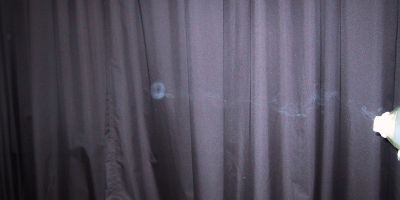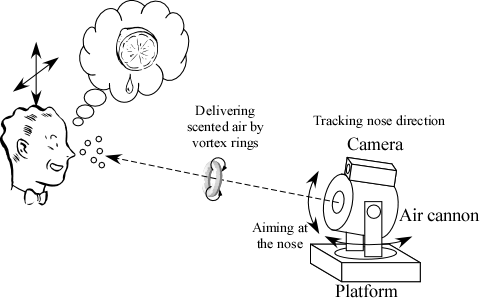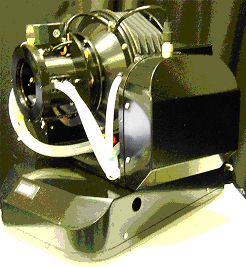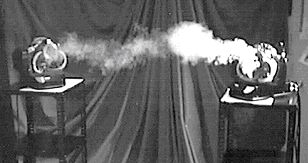
<<How can we deliver scented air from some nearby place to the nose?>>
[ Japanese / English ]
Page created: April 8, 2003
Updated: July 19, 2006

<<How can we deliver scented air from some nearby place to the nose?>>
In the early days of virtual reality (VR), where we had only audio and visual interfaces, people could not touch objects in the world, even though they were visible. After various types of haptic and tactile interfaces became available, the situation has markedly improved in relation to touch solid objects. However, we have not yet acquired ways to interactively enjoy smell or taste. If we could realize a VR interface that make use of full of five senses (and proprioception), that might be called an "ultimate interface."

As we can feel scent (or smell) without explicitly contacting solid objects or liquid, olfaction might be good for enhancing experience in simulated or remote environments using VR interfaces.
There are many difficult problems to realize interactive olfactory displays that can be used in VR applications. In general, there are several stages to record and playback using a certain sensory modality: sensing, coding, storage/transfer/communication, decoding/rendering/synthesizing, and final display. In every stage in this flow (except for generic storage/transfer/communication stage) we have challenging problems to achieve general-purpose, interactive olfactory display environments.

Here we might say there is a serious difficulty in the characteristics of our olfaction. For the case of vision, there is a psysiological validity in compressing color information: continuous spectrum to the mixture of three primary colors (Red, Green and Blue). For tactile sensation, some researchers have been trying to independently stimulate several kinds of mechano-receptor under the skin (Meissner corpuscle, Melker cell, Pacinian corpuscle, etc.), to display arbitrary tactile sensation. However, there is no such mechanisms found in olfaction. The number of detectors of our olfaction is considered to be thousands, so it is difficult to code the odorants as the mixture of small number of "primary odors."
We would not deny efforts to find methods to code and synthesize arbitrary scent. However, it seems to be too difficult for us. Therefore we would like to focus on developing olfactory "display" devices, rather than sensing, coding, and synthesizing technology related to olfaction. Our standpoint is to provide convenient tools to make interactive olfactory displays popular, even if they have no function to synthesize various kinds of scent.
Our goal is to develop an olfactory display with both of the following characteristics:
By localizing the scent, we can display different smells to multiple users. Also, we can significantly reduce the amount of (often expensive) odorant compared with just diffusing the scent into an entire room, as the volume of the air with odorant is so small. The system can thus be relatively cost-effective. In addition, this small clump of scented air can easily dissipate in a short time, which enables us to wield short-term control of the olfactory effect.

Concept of the system.
We explore a way to transfer scented air through free space, and found that a so-called "air cannon" could be used for this purpose. An air cannon (also known as a vortex cannon) is a chamber with a round aperture and a deformable part, and it is very popular in science demonstrations for children. It can launch a small clump of air (doughnut-shaped vortex ring) that can travel several meters. The travel distance depends on the geometry of the chamber and aperture, impact speed, etc. We have experimentally confirmed the vortex ring can travel at least 4-5m for larger air cannons.
We conducted a preliminary experiment if an air cannon successfully deliver scents to a specific user. The subject could not find the smell when the vortex ring hit another user's face sitting by side. The basic concept and the result of the preliminary experiment was presented at ACM CHI2003 Interactive Posters (here is our paper).
Here are movie files to show how the clump of air travels through free space. We filled an air cannon (made of PET bottle) with incense smoke, and gently pushed the rubber membrane at the bottom of the bottle.
| Format | Pixels | File size |
| Windows Media 9 | 640x480 | 1,850KB |
| QuickTime (Small) | 240x180 | 342KB |
The first prototype system was just a simple electro-mechanically driven air cannon unit. It was composed of a scent generator (commercial aroma diffuser: Hippocampe by Jacques G. Paltz), and an air cannon. The back of the chamber was covered with a rubber membrane and was driven by solenoids.
The second prototype system was made to incorporate nose-tracking function. It was composed of a scent generator (aroma diffuser), an air cannon, a 2-degrees-of-freedom platform and a CCD camera. A loudspeaker was used instead of solenoids at the back of the chamber, in order to reduce the impact noise when launching scented air. An image-based nose tracker (developed by Kawato et al.) is used.
This prototype was presented at SIGGRAPH2003 Sketches & Applications (here is our paper).
The third prototype has been configured to achive scent-switching function. This model was first demonstrated at ATR Expo 2003 (November 6-7, 2003).
For this model, we used bellows-type air cannon to obtain sufficient stroke (details described in our ICAT 2003 paper). We placed a short tube attached to the aperture of air cannon for scent switching. Scented air is introduced into this short tube, which is seperated from the body of air cannon by a shutter, so that different smells would not be mixed in the air cannon body. The shutter is opened just before the shot so that the scented air in the tube is completely launched off the air cannon, which makes it possible to fill different scent for next shot. Details on scent switching are described in our IEEE VR2004 paper.
By implementing nose-tracking function and scent-switching function, this prototype system has sufficient function to achieve our proposed concept (though there is still a room to improve performance).
| Format | Pixels/bitrate | File size |
| Windows Media 9 (Large) | 640x480/variable (~1Mbps) | 12,111KB |
| Windows Media 9 (Medium) | 320x240/340kbps | 3,916KB |
| Windows Media 9 (Medium) | 320x240/150kbps | 1,770KB |
| Windows Media 9 (Small) | 160x120/48kbps | 610KB |

During demonstrations by the above scnet projector prototypes, we found a problem with our scent-projection technique. Users felt an unexpectedly strong current of wind, caused by the airflow accompanying the vortex ring. It would be possible to prevent this wind effect by waiting until the vortex ring collapsed into itself, but the behavior of a self-collapsing vortex ring is too unstable to reliably deliver the scent to the user.

To solve this problem, we propose a novel approach: to intention-ally break vortex rings while they are flying stably by making them collide with each other. With this configuration, the scented air is carried from a nearby place to stay a while at a certain location. After the vortex rings break, the wind effect is much smaller than when a vortex ring directly hits the user's face, thus providing a more natural olfactory experience.
We made a pair of air cannon units for this system. This model is similar to our third prototype system described above, but with larger geometry. This concept was first demonstrated at SIGGRAPH 2005 Emerging Technologies.

Papers written in English
Papers written in Japanese
(to be written...)